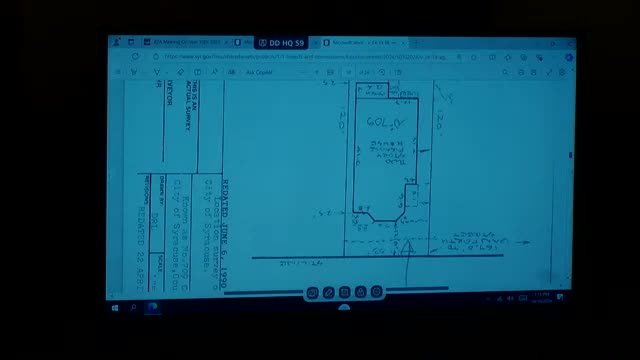Councilor fights for disabled parking rights in Syracuse
October 10, 2024 | Syracuse City, Onondaga County, New York
This article was created by AI summarizing key points discussed. AI makes mistakes, so for full details and context, please refer to the video of the full meeting. Please report any errors so we can fix them. Report an error »

During a recent government meeting, discussions centered around a proposed use variance for a residential property in Syracuse, highlighting significant concerns regarding accessibility and parking. The property, built in 1910, faces challenges due to its narrow lot, which measures only 33 feet wide. This limitation raises questions about the feasibility of parking a vehicle, as the available space between the house and the property line is insufficient for standard parking requirements.
City officials noted that the property currently lacks a curb cut, complicating access for residents, particularly those with disabilities. A representative from the city staff confirmed that plans for handicapped parking in front of the house were included in the staff report, although the necessity of a video demonstration of wheelchair use was debated.
Marty Naveh, the 1st district councilor, voiced strong support for the homeowner, emphasizing the historical context of the property and the need for accessible parking solutions. He argued that many homes in the area were built without consideration for modern vehicle ownership and that the city’s curb and sidewalk program should account for these older structures. Naveh highlighted the unfairness of the situation, particularly for residents with disabilities, and pointed out that similar cases had previously been accommodated by the city.
The meeting underscored the ongoing challenges faced by residents in adapting to changing urban infrastructure while maintaining accessibility for all community members. As discussions continue, the city must balance historical property considerations with modern accessibility needs.
City officials noted that the property currently lacks a curb cut, complicating access for residents, particularly those with disabilities. A representative from the city staff confirmed that plans for handicapped parking in front of the house were included in the staff report, although the necessity of a video demonstration of wheelchair use was debated.
Marty Naveh, the 1st district councilor, voiced strong support for the homeowner, emphasizing the historical context of the property and the need for accessible parking solutions. He argued that many homes in the area were built without consideration for modern vehicle ownership and that the city’s curb and sidewalk program should account for these older structures. Naveh highlighted the unfairness of the situation, particularly for residents with disabilities, and pointed out that similar cases had previously been accommodated by the city.
The meeting underscored the ongoing challenges faced by residents in adapting to changing urban infrastructure while maintaining accessibility for all community members. As discussions continue, the city must balance historical property considerations with modern accessibility needs.
View full meeting
This article is based on a recent meeting—watch the full video and explore the complete transcript for deeper insights into the discussion.
View full meeting
